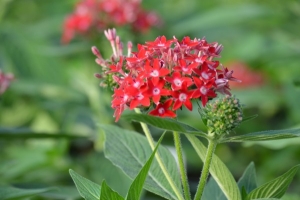There are two types of gardeners. Those who make a bee-line for the garden center as soon as it opens in the spring emerging with pots of pansies and perennials eager to get a head-start on the gardening season. Sometimes they are back to fill in holes over the summer. Other’s hang up their gloves and are done planting until the following spring.
The other group of gardeners waits until after Mother’s Day to plant. When fear of frost and winter temps are but a distant memory. The first group often misses some great overlooked annuals to fill in summer color. Many of these don’t look like much until the heat of summer.

Lantana is also a butterfly magnet in my flower beds. This sprawling, very drought tolerant South American native has been in Southern gardens for years where it can reseed and be a bit of a thug. Luckily we are far enough North reseeding is not an issue. Breeders also have been busy improving the habit. Lantana mixes well in hanging baskets, and looks fantastic in the front of a border. Often several colors bloom together in the same flower cluster for strong visual interest. As an added benefit, the fragrant (odiferous?) foliage reportedly repels mosquitoes better than citronella.
Blue is an elusive color for annuals- one of the best blues for summer is evolvulus. A member of the morning glory family,
this one does not climb or reseed. Proven Winners introduced a great cultivar ‘Blue My Mind’ last year. This cute trailer makes a carpet of blue flowers or takes the place of lobelia in spring baskets that have melted in the heat.
If you are looking for tall and dramatic, try an old-fashioned favorite, spider flower. Cleome was a staple of my grandmother’s garden. These tall plants were sticky, scratchy, and the pink, white or lavender flower heads looked like alien space ships. They would fling their seeds with reckless abandon, ensuring their place in the back of the border forever. Newer hybrids are much better behaved,sans thorns and selections like ‘Señorita Rosalita’ don’t even reseed any longer. They, too, are often visited by butterflies and other pollinators.
If shade is your situation- fill in color with New Guinea impatiens or try browallia- bush violet. Browallia come in lovely shades of blue, purple or white. Generally they stay under one foot in height, and look great covering the bare knees of shrubs, or spilling out of shady containers.
These heat-lovers of summer will work hard for you when early cooler season flowers have given up the ghost. Or if you are like me, don’t always get to your beds until June.

 Petunias are just so ubiquitous. They may be everywhere but there is a good reason for that.
Petunias are just so ubiquitous. They may be everywhere but there is a good reason for that.